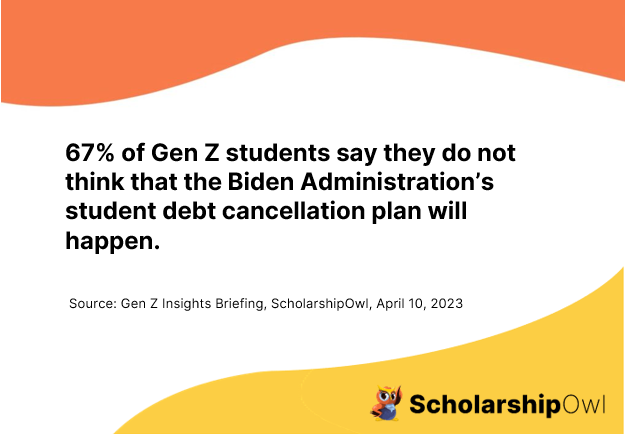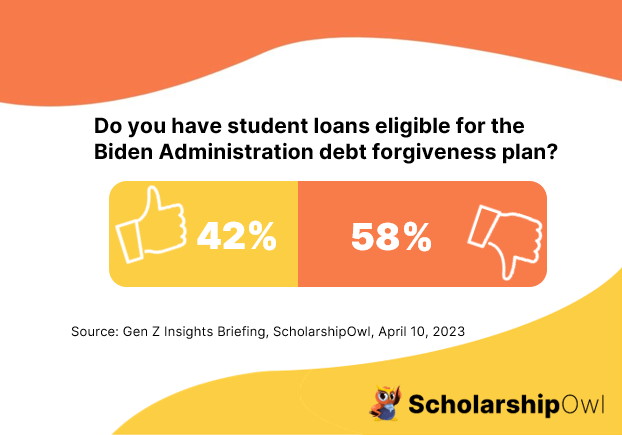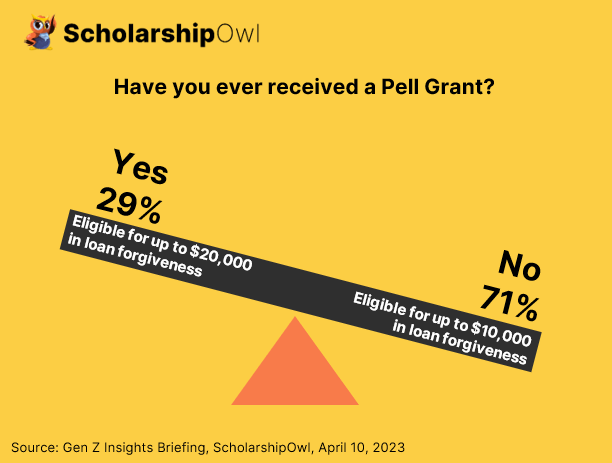Every month, ScholarshipOwl conducts a survey to develop a deeper understanding of Gen Z. In March, we delved deeper into student perspectives on the Biden Administration’s plan for student debt forgiveness. This survey is a follow-up to our February survey that focused on the impact of student debt on Gen Z.
Who participated in the survey?
In March 2023, ScholarshipOwl surveyed over 11,000 high school and college students on the ScholarshipOwl scholarship platform to learn how the Biden Administration plans for student debt forgiveness might impact them. We also polled students on whether or not they believed the plan would actually go into effect. A total of 11,033 students responded to the survey.
Background
Under the Biden Administration’s proposed one-time student debt cancellation plan, individuals must meet both of the following criteria to be eligible for debt forgiveness:
- You must have taken out one or more federal student loans prior to July 01, 2022;
- Your annual income must be less than $125,000 for individuals, or less than $250,000 for married couples or heads of household
Currently, the plan has been put on hold pending court cases that have challenged the plan. The Supreme Court is expected to announce their decisions in June 2023. In the meantime, students and families who meet eligibility criteria must wait for these decisions that will significantly impact their financial future.
The fastest path to earning scholarships
Simplify and focus your application process with the one-stop platform for vetted scholarships.
Survey questions
The first survey question was “Do you think that the federal student debt cancellation plan proposed by the Biden Administration will happen?” Check for scholarships
More than two-thirds (67%) responded that they did not think that the proposed plan would go forward.

As a follow-up question, we asked, “If the Biden Administration student debt cancellation plan is able to move forward, will you have any student loans that would be eligible for forgiveness?” Just under half of the respondents (42%) said that they would have one or more loans that would qualify for forgiveness under this plan.

The final survey question was designed to determine what level of loan forgiveness the respondents could potentially qualify for – up to $10,000 for students with one or more qualifying student loans, or up to $20,000 for students who had received a Pell Grant. We asked survey participants “Have you ever received a Pell Grant?” Among those who were surveyed, 29% of respondents had received a Pell Grant, and would then be eligible to receive up to $20,000 in student loan forgiveness if they also had taken out qualifying student loans.

Key Takeaways for Gen Z students
The survey results indicate that the majority of respondents don’t believe that the Biden Administration’s plan for one-time student debt forgiveness will move forward; however, this doesn’t mean that they don’t want it to happen. In fact, a poll completed on behalf of Newsweek in March 2023 that surveyed registered voters shows that 62% of Americans support the Biden Administration student debt forgiveness plan. Younger participants overwhelmingly supported the plan, with 71% of those aged 18 to 24 and 82% of those aged 25 to 34 backing the plan. What is perhaps most surprising is that 50% of those who voted for Donald Trump in the 2020 election also support the Biden Administration’s plan for student loan forgiveness.
Our survey also demonstrates that nearly half of today’s students would qualify for some amount of student loan forgiveness, with 29% qualifying for up to $20,000 in forgiveness – if the plan is able to move forward. However, given the realities of the current political climate, it is imperative that those who have student loans not rely on the hope of loan forgiveness. Even more importantly, those who are still in school should avoid taking on new debt if at all possible, and focus on paying for college with scholarships, federal and state grants and income from employment. These are the best sources of funds to pay for college, and to avoid graduating with the burden of debt.
Brands can offer a new solution
While students can earn scholarships to pay for college, the reality is that there aren’t nearly enough scholarships available to meet the needs of students who are applying for them. Brands can help by offering scholarship campaigns that support students, while also fulfilling their business and philanthropic goals. Through the ScholarshipOwl for Business platform brands can quickly and easily create and launch their scholarship campaigns, reaching the millions of students who apply for scholarships on the ScholarshipOwl platform. This not only benefits students, but also helps brands build relationships with Gen Z, supporting their marketing and communication goals.
To find out more about creating and launching a scholarship campaign, visit business.scholarshipowl.com.